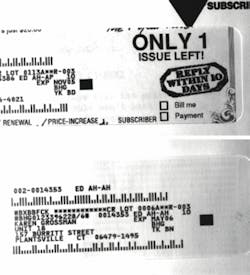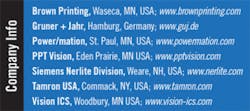Vision system tracks magazine production
Using a smart-camera configuration with LED illumination, system tracks end-of-zip-code symbols on magazine mailing address blocks.
By Nick Ward
The modern magazine-printing business is far more complex than simply printing paper and binding it together. In addition to special inserts, belly bands, polybagged extras, and other value-added services, printers must handle renewal requests for each magazine. These requests are typically put into an envelope and glued to the front of the magazine, although the position and orientation are far from exact.
Brown Printing, now part of Gruner + Jahr and a subsidiary of the multimedia-company Berteslmann, prints more than 500 magazine titles, with sales in excess of $375 million. The company organizes the magazines with their renewal envelopes into zip codes to cut down on US postage costs and provide a more valuable product to its clients. At the end of each zip-code run, there is a special symbol indicating that the zip-code run has come to an end and the next magazine will go to a different zip code and, therefore, should be packaged separately.
This relatively new service needed an automated method to find the envelope, locate the billing address block, and spot the end-of-zip code symbol. The system also needed to be able to communicate the position of the end-of-zip-code magazine to downstream packaging equipment. It needed to track where that end-of-zip code magazine is located on the conveyor as it makes its way downstream to boxing and palletizing machines.
A missed symbol could result in thousands of dollars in additional postage caused by inaccurate postal presorts. Failure to track the break in the zip codes as the magazine stream continues down the conveyors could lead some magazines to the wrong ‘bucket’ or plastic wrapping PLC downstream prior to palletizing and shipping.
Brown needed 100% inspection of each magazine and renewal envelope for one of several key zip code symbols, with each code representing a different product line and client. The company turned to industrial automation specialist Power/mation, which, in turn, contracted machine-vision integrator Vision ICS for the final installation, service, and follow-up.
Power/mation chose a PPT Vision Impact T20 smart camera running the company’s Inspection Builder software for both image processing and user-interface design and data management, with illumination provided by a Siemens Nerlite LED array. End-of-zip-code envelope images are stored on a nearby desktop PC, which also connects to Brown’s local-area network for remote data access.
Smart Cameras
The Impact T20 is a 640 × 480 monochrome VGA machine-vision camera with some added features. In addition to having image-processing capabilities inside the camera housing, the T20 has three 24-V inputs and five 24-V outputs for triggering and other I/O, as well as Ethernet and serial connections.
The Ethernet connection communicates to the nearby PC, which was already in place at the factory but was underutilized. The PC both archives images and provides an operator interface, which was designed in Inspection Builder software. It handles all non-real-time communications with the plant and the T20. It also logs all relevant data, such as the number of magazines per zip code (see Fig. 1 on p. 23).
Brown wanted the same inspection routine for three different end-of-zip-code symbols, with the capability to add new inspection tasks or alter existing symbol/zip-code inspections as new products emerged. The graphical user interface also had to allow the operator to train the system on new symbols, simply by collecting a picture of an envelope, using the mouse to outline a 4-in. region of interest where the symbol appears (namely, the address block as seen through envelope’s plastic window), and then highlighting the symbol in the picture (see Fig. 2).
Roll the Presses
In the system designed by Power/mation, the T20 is mounted off-axis and above the magazine conveyor. Off-axis placement helps to reduce intense glare from the plastic window on the envelope. The Nerlite red LED array also was placed above the conveyor and off-axis to illuminate the magazine cover. A photoeye placed above the conveyor looking down issues a 24-V trigger signal to the T20 when a magazine enters the inspection area. The T20 collects an image and uses a contour-based correlation algorithms to locate the symbol (when present) in the billing address window (see Fig. 3).
Contour-based correlation is similar to edge-based geometric pattern searches, but runs faster on the T20 than standard geometric pattern searches. Initially, the geometric pattern algorithm ran too slowly for the production line, and the end-of-zip-code signal transmitted along the 24-V output from the T20 was being delayed to the downstream PLC. The designers determined that, while the envelope wandered a bit on the magazine cover, its orientation was consistent. The data could be buffered but that resulted in errors in the shift register, which is the PLC program that tracks the end-of-zip-code magazine as it moves down the conveyor to the packaging station. Thus, by moving to contour-based correlation-which runs faster as long as orientation is not a concern-the company could boost the inspection speed to exceed that of the production line, conducting each inspection in 150 ms or less.
Images are transmitted across Ethernet to the PC, where they are displayed with the two previous images and the magazine number and other tracking data. The number of images displayed can also be changed through the graphical user interface (GUI).
When a new, much smaller symbol was introduced into the process, the 8-mm Tamron lens on the T20 was not sufficient. Moving to a 25-mm Tamron lens solved the problem, providing a working distance of 12 to 16 in.
Nick Ward is a vision specialist at Power/mation, St. Paul, MN, USA; www.powermation.com.
null




